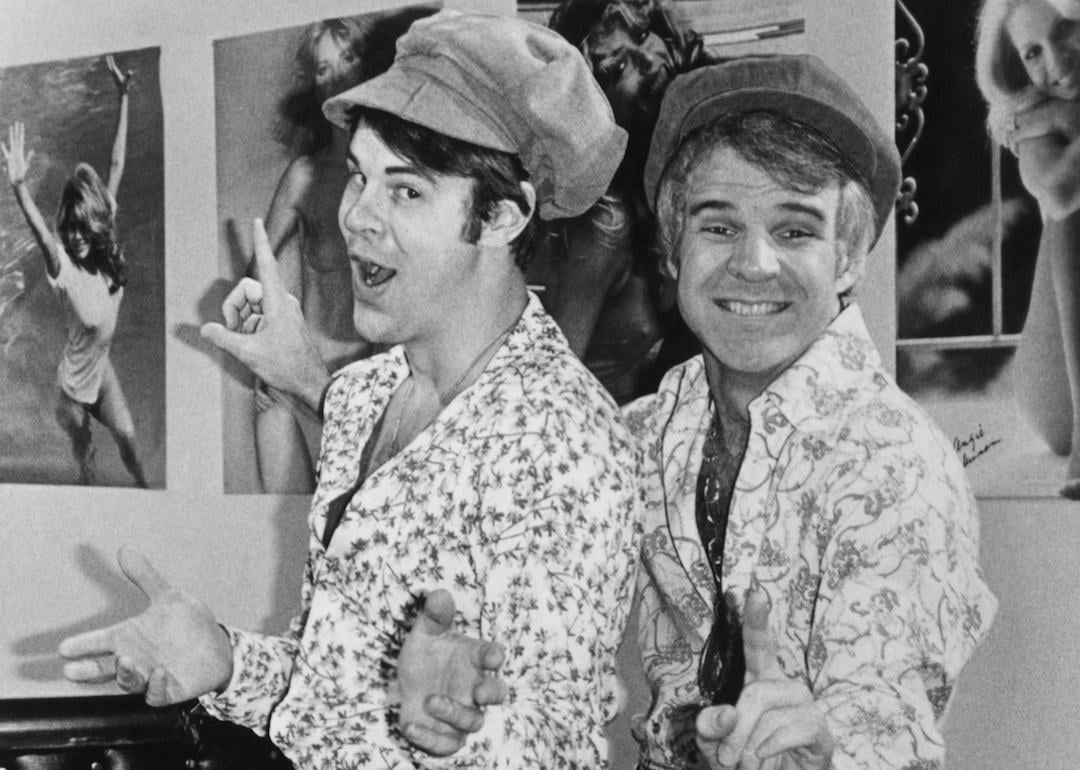
Facts you learned in school that are no longer true
Facts you learned in school that are no longer true
School curriculums contain plenty of useful subjects: algebra, grammar, chemistry. Of course, there are plenty of other lessons that didn't prove quite so accurate. From history classes that glossed over some crucial details to the health classes that used scare tactics rather than facts, it's almost guaranteed that every student learned a few lessons that turned out to be false.
Whether you went to a ritzy private academy or run-of-the-mill public school, it's time to put the lessons you learned to the test. Stacker scoured news articles and other expert sources for examples of commonly taught facts that were later proven false, urban legends that nevertheless made it into the classroom, and historic events that were oversimplified to the point of falsehood.
Read the full list to discover which scientific fact pretty much all schools got wrong before 2006, check whether you know the real story about the first Thanksgiving, and find out whether your teachers knew what they were talking about.
Pluto is a planet
Though Pluto had been recognized as the ninth and smallest planet in our solar system for decades, its status was downgraded to a dwarf planet in 2006. The discovery of other Kuiper Belt Objects that are roughly the same size as Pluto led to its change in status.
George Washington had wooden teeth
Oral hygiene and dentistry weren't exactly stellar in the 18th century, so it makes sense that George Washington and many of his contemporaries had false teeth. However, the first president's teeth weren't actually made of wood, as many students learn, but of lead, human teeth, cow teeth, and ivory.
Vincent van Gogh cut off his own ear
The idea of van Gogh slicing off his ear fits well with the idea of the tortured artist, but unfortunately, this fact isn't true. In 2009, two German historians released a book that claims that van Gogh actually lost the ear in a sword fight with artist Paul Gauguin.
Christopher Columbus discovered America
Christopher Columbus may have a holiday named after him, but he didn't actually discover America. Though the explorer did land on several islands in what is now the Bahamas, he never actually set foot on the North American continent. Bad news: He most likely didn't sail here in the Niña, Pinta and Santa Maria either.
Isaac Newton discovered gravity when an apple hit him in the head
Sir Isaac Newton still can be credited with discovering gravity, but he didn't get his bright idea after being smacked in the head by a falling apple. His brain wave actually occurred after watching an apple fall from a tree.
Albert Einstein was a bad student
The German-born physicist was certainly eccentric, but that didn't make him a bad student. Though teachers might like to tell students that Einstein wasn't always good at math to encourage them, he was actually always successful in school.
Pilgrims and Native Americans sat down together at the first Thanksgiving
Almost every detail that students are taught about the origin of Thanksgiving is false. No turkey or pumpkin pie was served, the Pilgrims didn't invite the Native Americans to their table, and they didn't celebrate Thanksgiving on the fourth Thursday in November.
The Great Wall of China is the only man-made structure that can be seen from space
Satellites orbiting Earth can see the Great Wall of China, but that's not the only man-made structure that's visible. If the weather conditions are right, astronauts in the International Space Station can see the pyramids, large bridges, and other large cities.
Raindrops are shaped like teardrops
The cartoon depiction of the raindrop looks a lot like a tear, but scientists say this isn't accurate. Most falling raindrops actually look flat—more like hamburger buns—according to the United States Geological Survey.
You can't start a sentence with a conjunction
Despite what your English teacher may have said, you can actually start a sentence with a conjunction. Grammar purists won't be happy about it, but who cares?
Deoxygenated blood looks blue
Possibly confused by the fact that some of your veins appear blue, many schoolchildren believe that blood only turns red when it's exposed to oxygen. However, this just isn't true.
If you swallow gum, it will stay in your stomach for seven years
Odds are, some resourceful parent or teacher decided to make up this untruth to stop kids from swallowing gum. Though chewing gum isn't as easily digested as other foods, it won't remain in your body for any length of time.
America became independent on July 4, 1776
July 4, 1776 was the day the 12 colonies signed the Declaration of Independence. In reality, America didn't become truly free until after the country won the Revolutionary War.
Diamonds are the hardest substance known to man
Two substances are actually harder than diamond: wurtzite boron nitride and lonsdaleite. However, since both are unstable in nature and extremely rare, you're very unlikely to encounter either.
Five kingdoms of classification exist
Biology classes typically include a lesson on the classification of life. Many children learned that there are five classifications—animals, plants, bacteria, fungi, and protists—but scientists now believe that there are as many as eight.
You only use 10 percent of your brain
There is a nugget of truth to this idea: About 90 percent of brain cells are white matter and are never used for thinking. However, all parts of the human brain are in use at all times—just not specifically for thought.
Chameleons change color to blend into their surroundings
These reptiles do frequently change colors, but they don't use these special abilities to camouflage themselves. Instead, chameleons use different colors to communicate with each other and control their body temperature.
Earth is the only planet with water
Teachers thought they were absolutely correct when they taught students that Earth was the only planet to contain water. However, recent NASA findings reveal that liquid water also flows on Mars.
Goldfish can only remember things for three seconds
No one is claiming that goldfish are particularly bright, but they at least deserve a little bit more credit than most people give them. Studies have shown that goldfish appear to remember what happens around them for as long as 12 days.
The United States is a democracy
Saying that the United States is a democracy might be oversimplifying our government. In fact, the founders established the country as a republic that combined elements of monarchy, aristocracy, and democracy.
Witches were burned at the stake in the United States
During the mass hysteria about witchcraft culminating in the Salem Witch Trials, witches were sentenced to death. However, they weren't actually burned—instead, most were hanged.
The Salem Witch Trials were caused by a fungus
An article written in the 1970s speculated that the Salem Witch Trials were actually triggered by ergot poisoning. Ergot—a fungus that can grow on rye in wet conditions—very possibly made its way into early settlers' bread, but its hallucinogenic properties were likely not strong enough to cause such mass hysteria.
Pilgrims wore only black and white clothing
Despite the popular image of Pilgrims wearing all black and white with a wide-brimmed hat and buckled shoes, this stereotype isn't true. Black and white outfits were typically reserved for Sundays and special occasions, while men and women wore all kinds of colors during the week.
Following the food pyramid is the best way to eat
Children who grew up between the 1970s and 90s likely remember the food pyramid, a visual aid that taught students to eat mostly carbs, then vegetables and fruit, then meat and dairy products. Since then, the United States Department of Agriculture has totally overhauled its nutrition program to promote a more balanced diet of whole grains, fruit, vegetables, and protein.
Eating chocolate gives you acne
Many pimply teenagers probably remember a health teacher instructing them to lay off the chocolate to clear up their skin. While there is some evidence that sugar can exacerbate acne, most doctors agree that chocolate itself can't cause breakouts.
The five-second rule is accurate
Here's another common lesson that teachers likely used to make their lives easier: You can safely eat anything that drops on the floor as long as it didn't rest there for longer than five seconds. In reality, however, it only takes a fraction of a second for bacteria to contaminate a piece of food.
Coffee stunts your growth
Though parents still probably don't like the idea of their kids drinking coffee at a young age, they'll have to find another rationale to stop them. There is no evidence that caffeine can have significant impacts on physical growth.
Sugar causes hyperactivity in children
In 1974, Dr. William Cook wrote a letter to the American Academy of Pediatrics detailing his belief that sugar causes hyperactivity in children. The idea took off from there, though studies have failed to find any link between the two.
Dogs are colorblind
Dogs do see colors differently than humans, but they're not actually colorblind. In fact, canines can see blues and greens, and have better vision in low light than humans.
Dropping a penny from the Empire State Building could kill a passerby
Teachers often used this fun fact to teach physics principles like velocity. However, the math just doesn't add up: At most, a penny falling from the top of the Empire State Building would hurt you quite a bit.



